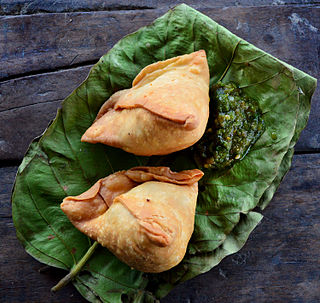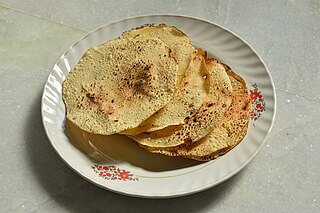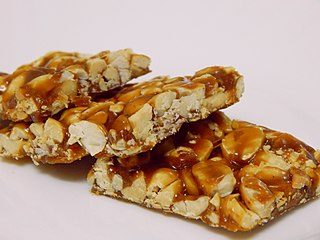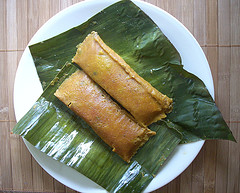
Caribbean cuisine is a fusion of West African, Creole, Amerindian, European, Latin American, Indian/South Asian, Chinese, North American, and Middle Eastern cuisines. These traditions were brought from many countries when they moved to the Caribbean. In addition, the population has created styles that are unique to the region.

The chickpea or chick pea is an annual legume of the family Fabaceae, subfamily Faboideae, cultivated for its edible seeds. Its different types are variously known as gram or Bengal gram; chhola, chhana, chana, or channa; garbanzo or garbanzo bean; or Egyptian pea. It is one of the earliest cultivated legumes, the oldest archaeological evidence of which was found in Syria.

Hummus, also spelled hommus or houmous, is a Middle Eastern dip, spread, or savory dish made from cooked, mashed chickpeas blended with tahini, lemon juice, and garlic. The standard garnish in the Middle East includes olive oil, a few whole chickpeas, parsley, and paprika.

Falafel is a deep-fried ball or patty-shaped fritter of Egyptian origin, featuring in Middle Eastern cuisine, particularly Levantine cuisines, and is made from broad beans, ground chickpeas, or both.

A samosa from the Persian word sambosag (سنبوسگ) is a fried South Asian and West Asian snack. It is a pastry with a savory filling, mostly vegetables, spiced potatoes, onions, and peas, but also meat or fish. It is made in different shapes, including triangular, cone, or crescent, depending on the region. Samosas are often accompanied by chutney, and have origins in medieval times or earlier. Sweet versions are also made. Samosas are a popular entrée, appetizer, or snack in the cuisines of India, South Asia, West Asia, Central Asia, East Africa and their South Asian diasporas.

Farinata, socca, farinata di ceci, torta di ceci, fainé, fainá,cecìna or cade is a type of thin, unleavened pancake or crêpe made from chickpea flour.

Chaat, or chāt is a family of savoury snacks that originated in India, typically served as an hors d'oeuvre or at roadside tracks from stalls or food carts across South Asia in India, Pakistan, Nepal and Bangladesh. With its origins in Uttar Pradesh, India, chaat has become immensely popular in the rest of South Asia.

A papadam, also known as papad, is a snack that originated in the Indian subcontinent. Dough of black gram bean flour is either deep fried or cooked with dry heat until crunchy. Other flours made from lentils, chickpeas, rice, tapioca, millet or potato are also used. Papadam is typically served as an accompaniment to a meal in India, Pakistan, Bangladesh, Nepal, Sri Lanka and the Caribbean or as an appetizer, often with a dip such as chutneys, or toppings such as chopped onions and chili peppers, or it may be used as an ingredient in curries.

Dhokla is a savoury sponge dish that is native to the Indian state of Gujarat and parts of adjacent states, and is popular throughout the country. It is made with a fermented batter that is steamed to a cake-like consistency. The batter consists of a mixture of rice with the pulse Bengal gram, but has several variants with the gram replaced by chickpeas, pigeon peas, or urad beans.

Bean salad is a common salad composed of various cooked beans—typically green, wax, kidney, and/or lima beans—tossed in a sweet-sour vinaigrette. Variant ingredients include fresh raw onions, bell pepper, and/or other cooked or raw vegetables, such as chickpeas.

Chikki is a traditional Indian sweet (brittle) generally made from nuts and jaggery/sugar. There are several different varieties of chikki in addition to the most common groundnut (peanut) chikki. Each variety of chikki is named after the ingredients used, which include puffed or roasted Bengal gram, sesame, puffed rice, beaten rice, or khobra, and other nuts such as almonds, cashews and pistachios.

Pasteles, also pastelles in the English-speaking Caribbean, are a traditional dish in several Latin American and Caribbean countries. In Puerto Rico, the Dominican Republic, Venezuela, Panama, Trinidad and Tobago, and the Caribbean coast of Colombia, the dish looks like a tamal. In Hawaii, they are called pateles in a phonetic rendering of the Puerto Rican pronunciation of pasteles, as discussed below.

Batata vada is a popular vegetarian fast food dish from the Indian state of Maharashtra. The dish consists of a mashed potato patty coated with chickpea flour, which is then deep-fried and served hot with chutney. The vada is typically around two or three inches in diameter. Across different regions of India, this dish is also known as aloo bonda, aloo vada, batata bonda, potato bonda and potato vada.

Burmese tofu is a food of Shan origin and of Chinese from Yunnan Province, made from water and flour ground from yellow split peas and the Burmese version of chickpea flour, also known as besan flour, in a fashion similar to polenta. The flour is mixed with water, turmeric, and a little salt and heated, stirring constantly, until it reaches a creamy consistency. It is then transferred into a tray and allowed to set. It can also be made using dried chickpea instead of processed flour. In this process, dried chickpeas are soaked overnight. Once the peas have been re-hydrated, they are ground into a puree with some of the liquid used to soak the peas, then allowed to set for a couple of hours. Much of the top layer of clear liquid is then skimmed off and the remaining puree is brought to a boil with turmeric and salt and cooked and set in the same manner as the version using chickpea flour. It is matte yellow in colour, jelly-like but firm in consistency, and does not crumble when cut or sliced. It may be eaten fresh as a Burmese tofu salad or deep-fried into a Burmese fritter. It may also be sliced and dried to make crackers for deep frying. Despite the name, Burmese tofu is unrelated to Chinese tofu, which is made from soy milk with added coagulants.

Cocido madrileño is a traditional chickpea-based stew associated to the Madrid region. It is most popular during the winter. Long-cooking cocidos are thought to be derived from Sephardic adafina recipes.

Ghugni or guguni is a dish made of peas or chickpeas in Nepal, India and Bangladesh. Different variations of the dish use different types of peas or chickpeas, such as black gram, green peas, or white peas. It is usually eaten for breakfast with toasted bread or puri but can also be served as the main course for lunch or dinner. It can be made either with or without the use of onion and garlic. It is a curry native to the Indian subcontinent.

A tomato omelette is a breakfast dish prepared mostly in Maharashtra, India. It is referred to as an omelette because of its visual appearance, but this is a misnomer, as it actually contains no egg product or by-product and is vegan. The main ingredient is chickpea flour or besan. Sometimes, it is also made with dosa batter, with a small quantity of besan only to provide binding, in which case it is classified as Uttapam.

Afritada is a Philippine dish consisting of chicken, beef, or pork braised in tomato sauce with carrots, potatoes, and red and green bell peppers. It is served on white rice and is a common Filipino meal. It can also be cooked with seafood.






























